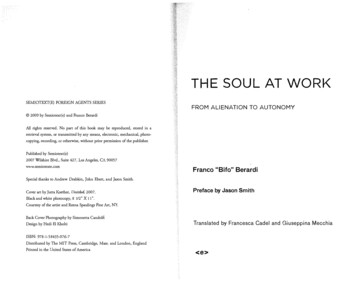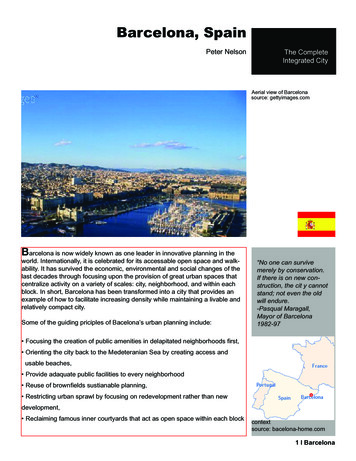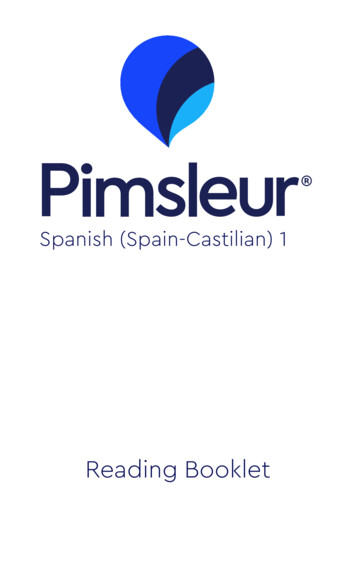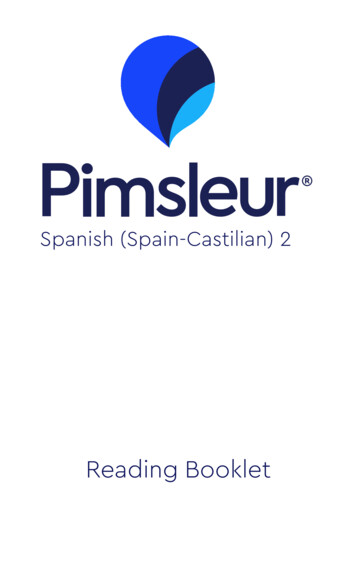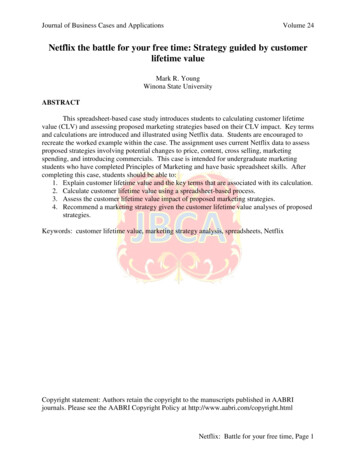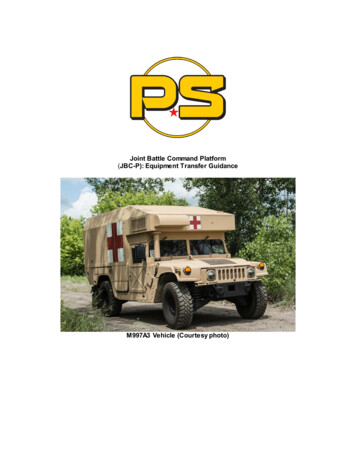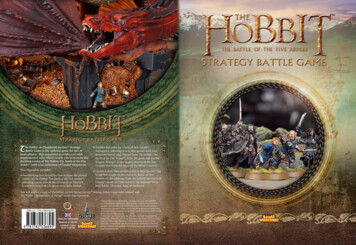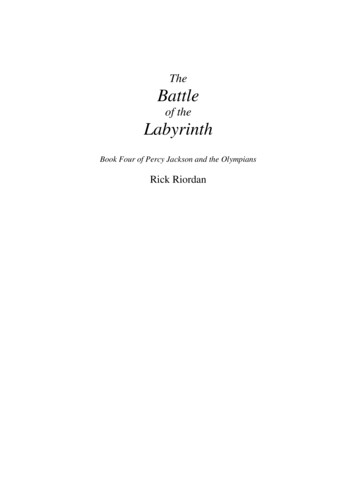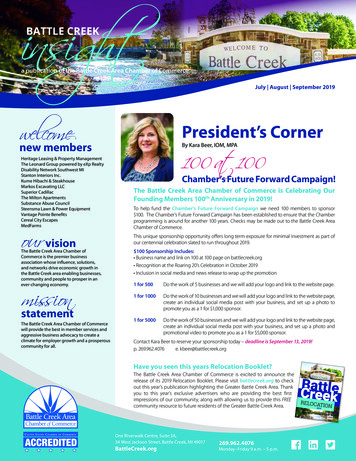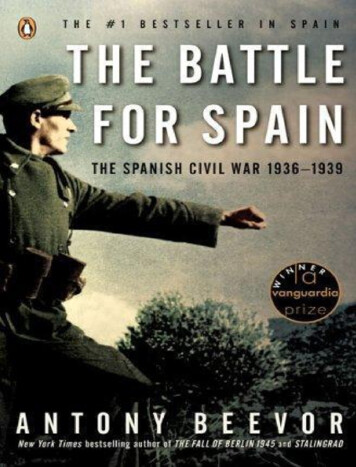
Transcription
THE BATTLE FOR SPAIN
Books by the same authorThe Spanish Civil War (1982)Inside the British Army (1990)Crete: the Battle and the Resistance(1991)Paris After the Liberation (withArtemis Cooper, 1994)Stalingrad (1998)Berlin: The Downfall (2002)The Mystery of Olga Chekhova (2004)
A Writer at War: Vasily Grossman withthe Red Army 1941–1945 Edited andtranslated with Luba Vinogradova(2005)
THE BATTLE FOR SPAINTHE SPANISH CIVIL WAR 1936–1939
ANTONY BEEVOR
Weidenfeld & NicolsonLONDON
First published in Great Britain in 2006by Weidenfeld & NicolsonAn earlier version of this book waspublished by Orbis Publishing Ltd in1982under the title The Spanish Civil War Ocito Ltd 2006All rights reserved. No part of thispublication may be reproduced, storedin a retrieval system, or transmitted, inany form or by any means, electronic,mechanical, photocopying, recording orotherwise, without the prior permission
of both the copyright owner and theabove publisher.The right of Antony Beevor to beidentified as the author of this work hasbeen asserted in accordance with theCopyright, Designs and Patents Act1988.A CIP catalogue record for this book isavailable from the British Library.ISBN: 1-4295-1201-6The Orion Publishing Group’s policy is
to use papers that are natural, renewableand recyclable products and made fromwood grown in sustainable forests. Thelogging and manufacturing processes areexpected to conform to theenvironmental regulations of the countryof origin.Weidenfeld & NicolsonThe Orion Publishing Group LtdOrion House5 Upper Saint Martin’s LaneLondon, WC2H 9EAwww.orionbooks.co.uk
For Gonzalo Pontón with all mygratitude for all his help
CONTENTSLIST OF ICAL PARTIES,GROUPINGS ANDORGANIZATIONSINITIALS
PART ONE:Old Spain and the Second Republic1 Their Most Catholic Majesties2 Royal Exit3 The Second Republic4 The Popular Front5 The Fatal ParadoxPART TWO:The War of Two Spains6 The Rising of the Generals7 The Struggle for Control8 The Red Terror
9 The White Terror10 The Nationalist Zone11 The Republican Zone12 The Army of Africa and thePeople’s MilitiasPHOTOGRAPHIC INSERT IPART THREE:The Civil War Becomes International13 Arms and the Diplomats14 Sovereign States15 The Soviet Union and the SpanishRepublic
PHOTOGRAPHIC INSERT II16 The International Brigades and theSoviet Advisers17 The Battle for MadridPART FOUR:World War by Proxy18 The Metamorphosis of the War19 The Battles of the Jarama andGuadalajara20 The War in the North21 The Propaganda War and the
IntellectualsPART FIVE:Internal Tensions22 The Struggle for Power23 The Civil War within the Civil War24 The Battle of Brunete25 The Beleaguered Republic26 The War in Aragón27 The Destruction of the NorthernFront and of Republican IdealismPART SIX:The Route to Disaster
28 The Battle of Teruel and Franco’s‘Victorious Sword’29 Hopes of Peace Destroyed30 Arriba España!31 The Battle of the Ebro32 The Republic in the EuropeanCrisis33 The Fall of CataloniaPHOTOGRAPHIC INSERT III34 The Collapse of the RepublicPART SEVEN:
Vae Victis!35 The New Spain and the FranquistGulag36 The Exiles and the Second WorldWar37 The Unfinished War38 Lost CausesBIBLIOGRAPHYSOURCESNOTESINDEX
LIST OF ILLUSTRATIONSSections of photographs appear on endof the book.PHOTOGRAPHIC INSERT I:King Alfonso XIII getting to know hispeople1King Alfonso XIII with General MiguelPrimo de Rivera2Crowds celebrating in Madrid, 14 April19312Lerroux, President Alcalá Zamora andGil Robles, 19343Civil guards arrest a socialist in Madrid,October 19343
Civil Guards escort their prisoners afterthe failed revolution in Asturias,October 19343José Antonio Primo de Rivera andfellow Falangists3Shooting breaks out during the funeral ofa civil guard officer suspected of anattempt to kill President Azaña, April19363Franco reaches Ceuta from the CanaryIslands to take over command of theArmy of Africa, 18 July 19361Carlist volunteers flock to the mainsquare of Pamplona to become GeneralMola’s main force, 19 July 19364Assault guards and anarcho-syndicalistworkers of the CNT with a captured
field-gun in Barcelona3POUM militia in the Carlos Marxbarracks in Barcelona3A bandera of the Foreign Legion roundsup villagers during Yagüe’s advancenorth, August 19363Colonel Varela’s troops advance intoToledo, 28 September 19362Colonel Moscardó, Varela and Francocelebrate the relief of the Alcázar ofToledo3Yagüe, Franco and Serrano Súñer3Luftwaffe pilots with their Heinkel He45 fighter-bombers3PHOTOGRAPHIC INSERT IIDoloresIbárruri,:‘LaPasionaria’,
making a speech, 14 October 19362The captain of a Soviet ship iswelcomed by Companys and AntonovOvseenko3Mikhail Koltsov and Roman Karmen inthe trenches before Madrid2The fighting in the Casa de Campo,November 19363Refugees sheltering in the Madrid metroduring an air-raid3International Brigade troops marchthrough Madrid3Propaganda photo of a Soviet pilot withhis ‘Chato’2Women in Málaga terrified by anationalist air raid3Carliest requetés being blessed before
going into battle3Colonel Wolfram von Richthofen withnationalist and Condor Legion officers3El Campesino making a speech3Juan García Oliver broadcasts an appealfor calm during the May events inCatalonia3Assault guards brought in to restoreorder marching through Barcelona, 6May 19372General Pozas and communist officerstake over the Catalan council of defence,May 19373Juan Modesto at the Battle of Brunete,July 19372Republican wounded at Brunete2
PHOTOGRAPHIC INSERT III:The winter fighting of Teruel, December19372An International Brigade officer atTeruel2Prieto observes the fighting at Teruel2Condor Legion Stukas with nationalistmarkings, 19382Panzer Mark Is advancing3The nationalists reach the sea at Vinaròs,15 April 19382Condor Legion 88mm anti-aircraft guns,summer 19382Republican soldiers under bombardmentduring the Battle of the Ebro2A republican hospital train behind theEbro front, summer 19383
General Rojo, Juan Negrín and Líster ata farewell parade for the InternationalBrigades, October 19382Colonel Casado listens while JuliánBesteiro broadcasts the manifesto of theNational Council of Defence, March19395Republican refugees swarm across theFrench frontier in the Pyrenees, January19396Republican prisoners in the Frenchinternment camp of Le Vernet3Condor Legion standard dipped in saluteto Franco at the victory parade, 19 May19392The indoctrination of republicanorphans3
Hitler and Franco meet at La Hendaye(photo montage), October 19402The Spanish Blue Division in Russia onthe Leningrad front21Arxiu Nacionalde Catalunya2AgenciaEFEedition of The Battle forSpain (The Spanish Civil War)4La Vanguardia5Archivo General de la Administración6Getty Images3PreviousWhile every effort has been made totrace copyright holders, if any haveinadvertently been overlooked, thepublishers will be pleased to
acknowledge them ineditions of this work.anyfuture
ACKNOWLEDGEMENTSThis book has had a curious life. I beganwork on what can now be called theprototype version in 1976, not long afterthe death of General Franco. It wasfinally published in 1982 under the titleThe Spanish Civil War , soon afterColonel Tejero held the Cortes hostageat gunpoint in an attempt to overthrowthe democracy which had emerged underKing Juan Carlos. Then, four years ago,my Spanish publisher, Gonzalo Pontón,persuaded me to rewrite the bookcompletely. The idea was to use all theresearch carried out so painstakingly by
Spanish and other historians over thelast quarter of a century, as well as addnew material from German archives andespecially from Soviet files which hadnot been accessible.Gonzalo Pontón, the founderof Crítica, the publishing house whichhas brought out more books on recentSpanish history than any other, made theproject possible by sifting the hugenumber of books and academic paperson the subject which have appeared inrecent years. Quite literally this book,The Battle for Spain, would never havebeen possible without all his help andenthusiasm in completing a projectwhich proved far more extensive thanany of us had foreseen when he first
raised the idea. It has been an immensepleasure and a privilege to work withhim.Forallnon-Spanisheditions I have included the original,perhaps over-mechanistic, synopsis ofthe country’s history as a very briefreminder for readers. The structure ofthe book also remains more or less thesame as the prototype edition. The realdifference lies in the detail and thesources, but interestingly, I find that thehuge increase in information availabletoday has tended to swell the number ofvital questions rather than reduce them.This, on the other hand, may also be dueto the author losing some of the morepassionate certainties of youth over the
last 24 years.In any case, this book couldnever have been completed without agreat deal of help from other friends andcolleagues. In Russia, I am deeplygrateful once again to Professor AnatolyChernobayev for his advice and aboveall to my long-standing researchassistant, Dr Luba Vinogradova, towhom I owe so much already. As wellas the staff of numerous archives, I amparticularly indebted to those in thelibrary of ‘Memorial’ in Moscow.Angelica von Hase once again assistedme greatly in Germany, especially in theBundesarchiv-Militärarchiv in Freiburg.In Sweden, Björn Andersson and DrLars Erickson obtained documents for
me from the Swedish Krigsarkivet andAlan Crozier most kindly translated themfor me.In London, I have beenextremely lucky to work once again withIon Trewin, and as always, I am morethan happy to have another old friend,Andrew Nurnberg, as my agent. All thisturns publishing a book from a fraughtand stressful experience into a cooperative and delightful one. And onceagain, my greatest debt of all is, asalways, to my wife, Artemis Cooper,who has had to relive these years.
INTRODUCTION‘A civil war is not a war but a sickness,’wrote Antoine de Saint-Exupéry. ‘Theenemy is within. One fights almostagainst oneself.’ Yet Spain’s tragedy in1936 was even greater. It had becomeenmeshed in the international civil war,which started in earnest with thebolshevik revolution.The horrors in Russia hadundermined the democratic centrethroughout continental Europe. This wasbecause the process of polarizationbetween ‘reds’ and ‘whites’ allowedboth political extremes to increase their
own power by manipulating fearful, ifnot apocalyptic, images of their enemies.Their Manichaean propaganda fed offeach other. Both Stalin and Goebbelslaterexploited,with diabolicalingenuity, that potent combination of fearand hatred. The process stripped their‘traitor’ opponents of their humanity aswell as their citizenship. This is why itis wrong to describe the Spanish CivilWar as ‘fratricidal’. The divisiveness ofthe new ideologies could turn brothersinto faceless strangers and tradeunionists or shop owners into classenemies. Normal human instincts wereoverridden. In the tense spring of 1936,on his way to Madrid University, JuliánMarías, a disciple of the philosopher
José Ortega y Gasset, never forgot thehatred in the expression of a tram-driverat a stop as he watched a beautiful andwell-dressed young woman step downonto the pavement. ‘We’ve really hadit,’ Marías said to himself. ‘When Marxhas more effect than hormones, there isnothing to be done.’1The Spanish Civil War hasso often been portrayed as a clashbetween left and right, but this is amisleading simplification. Two otheraxes of conflict emerged: statecentralismagainstregionalindependence and authoritarianismagainst the freedom of the individual.The nationalist forces of the right weremuch more coherent because, with only
minor exceptions, they combined threecohesive extremes. They were rightwing, centralist and authoritarian at thesame time. The Republic, on the otherhand, represented a cauldron ofincompatibilities and mutual suspicions,with centralists and authoritarians,especially the communists, opposed byregionalists and libertarians.Ghosts of those propagandabattles of seventy years ago still hauntus. Yet the Spanish Civil War remainsone of the few modern conflicts whosehistory had been written moreeffectively by the losers than by thewinners. This is not surprising when oneremembers the international sense offoreboding after the Republic’s defeat in
the spring of 1939. Anger then increasedafter 1945, when the crimes of NaziGermany came to light and GeneralFranco’sobsessivevindictivenesstowards the defeated republicansshowed no sign of diminishing.It is difficult for youngergenerations to imagine what life wasreally like in that age of totalitarianconflict. Collectivist ideals, whetherthose of armies, political youthmovements or of trade unions, havevirtually all disintegrated. The passionsand hatreds of such an era are a worldaway from the safe, civilian environmentof health and safety, and citizen’s rightsin which we live today. That past isindeed ‘another country’. Spain itself
has changed completely in a matter ofdecades. Its emergence from the civilwar and Francoist era has been one ofthe most astonishing and impressivetransformations in the whole of Europe.This, perhaps, is why it is unwise to tryto judge the terrible conflict of seventyyears ago with the liberal values andattitudes that we accept today as normal.It is vital to make a leap of theimagination, to try to understand thebeliefs and attitudes of the time–whetherthe nationalistic, Catholic myths and thefear of bolshevism on the right, or theleft’s conviction that revolution and thecoercive redistribution of wealth couldproduce universal happiness.Such passionately fought
causes have made it far harder to beobjective, especially when one looks atthe origins of the war. Each side isbound to want to prove that the otherstarted it. Sometimes even neutralfactors tend to be neglected, such as thefact that the Republic was attempting tocar
The Spanish Civil War, soon after Colonel Tejero held the Cortes hostage at gunpoint in an attempt to overthrow the democracy which had emerged under King Juan Carlos. Then, four years ago, my Spanish publisher, Gonzalo Pontón, persuaded me to rewrite the book completely. The idea was to use all the research carried out so painstakingly by
